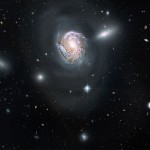 NASA’s Hubble Space Telescope photographed this amazing, spectacular and stunning image of spiral galaxy NGC 4911. If planning to visit, then take into account the fact that it lies over 320 million ligh-years away in the Coma cluster. If you want to see a larger image, just click the picture.
NASA’s Hubble Space Telescope photographed this amazing, spectacular and stunning image of spiral galaxy NGC 4911. If planning to visit, then take into account the fact that it lies over 320 million ligh-years away in the Coma cluster. If you want to see a larger image, just click the picture.
NGC 4911, contains rich lanes of dust and gas near its center. These are silhouetted against glowing newborn star clusters and iridescent pink clouds of hydrogen, the existence of which indicates ongoing star formation. Hubble has also captured the outer spiral arms of NGC 4911, along with thousands of other galaxies of varying sizes. The high resolution of Hubble’s cameras, paired with considerably long exposures, made it possible to observe these faint details.
NGC 4911 and other spirals near the center of the cluster are being transformed by the gravitational tug of their neighbors. In the case of NGC 4911, wispy arcs of the galaxy’s outer spiral arms are being pulled and distorted by forces from a companion galaxy (NGC 4911A), to the upper right. The resultant stripped material will eventually be dispersed throughout the core of the Coma Cluster, where it will fuel the intergalactic populations of stars and star clusters.
The Coma Cluster is home to almost 1,000 galaxies, making it one of the densest collections of galaxies in the nearby universe. It continues to transform galaxies at the present epoch, due to the interactions of close-proximity galaxy systems within the dense cluster. Vigorous star formation is triggered in such collisions.
Galaxies in this cluster are so densely packed that they undergo frequent interactions and collisions. When galaxies of nearly equal masses merge, they form elliptical galaxies. Merging is more likely to occur in the center of the cluster where the density of galaxies is higher, giving rise to more elliptical galaxies.
This natural-color Hubble image, which combines data obtained in 2006, 2007, and 2009 from the Wide Field Planetary Camera 2 and the Advanced Camera for Surveys, required 28 hours of exposure time.
You can obtain an even higher resolution image directly from the Hubble site by clicking here (its about 15Mb). Warning, the number of pixels high-resolution image contain can be problematic for some browsers. The image may not appear, and it may cause your Web browser to lock up, so an alternative is to simply download and then view with an appropriate image viewer.
The faith-based community need to invoke thoughts about mythical supernatural beings in order to invoke awe and wonder. However, those of us in the reality-based community need no such fantasies. Just gaze upon this stunning image and ask yourself what mysteries and life forms exist there, what unknowns are out there? Take a second look at the image. Those aren’t just stars in the background, its surrounded by thousands of other galaxies, and each one contains hundreds of billions of stars.
Via NASA/Hubble